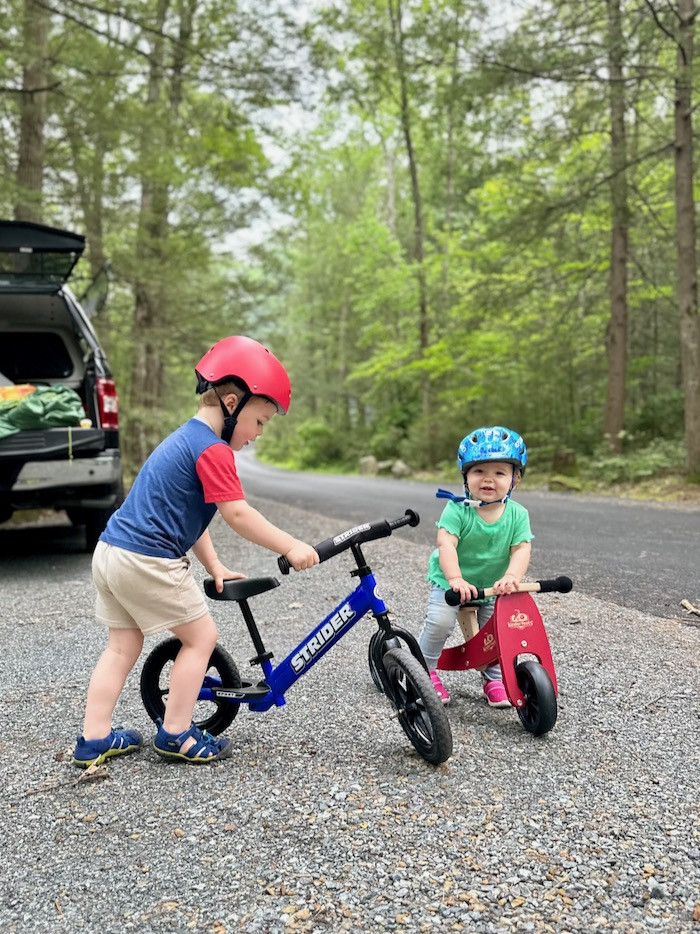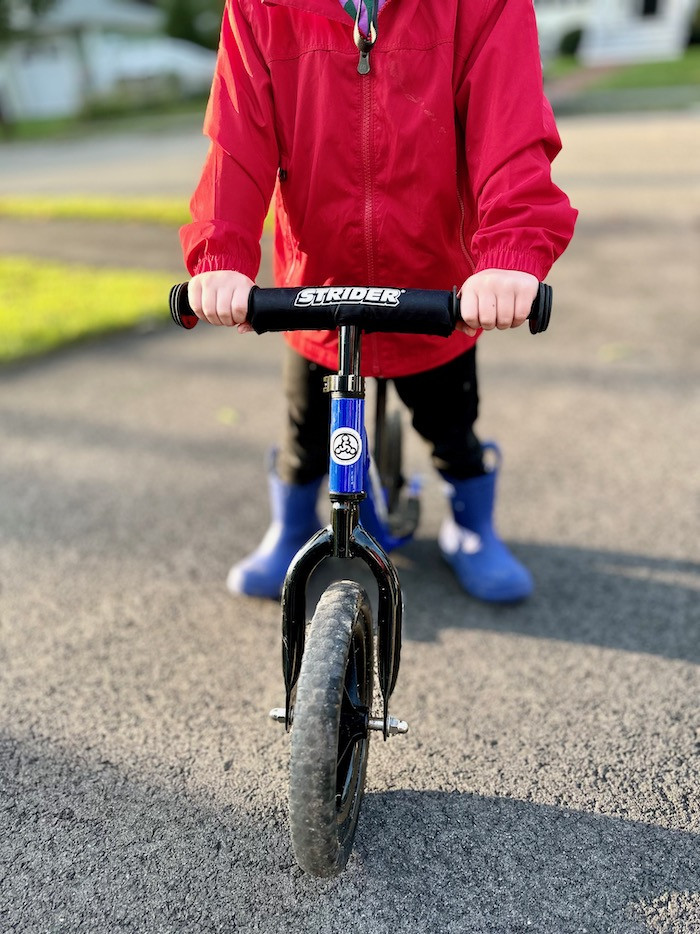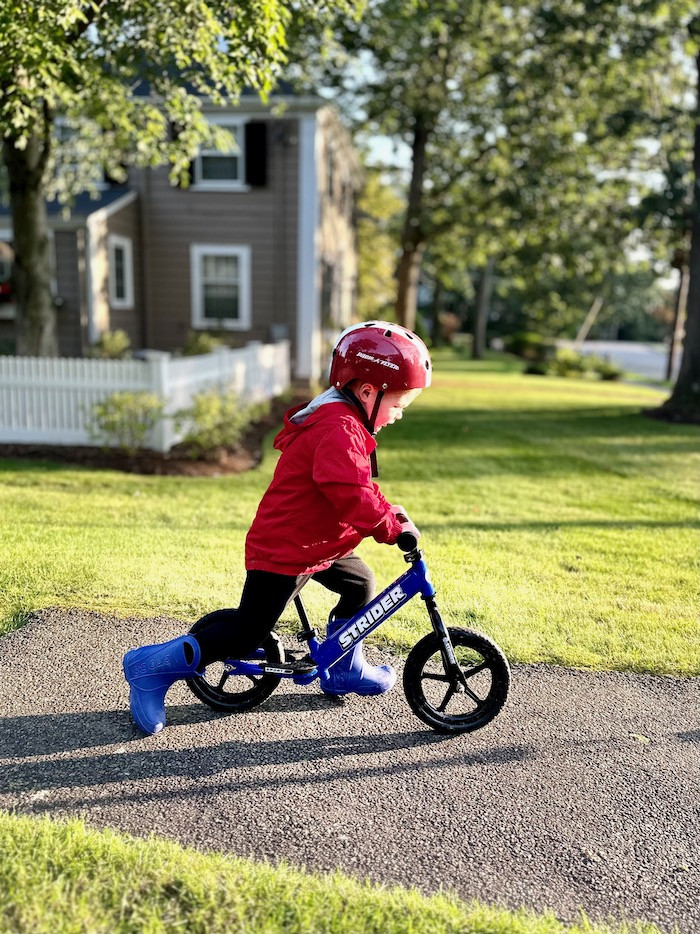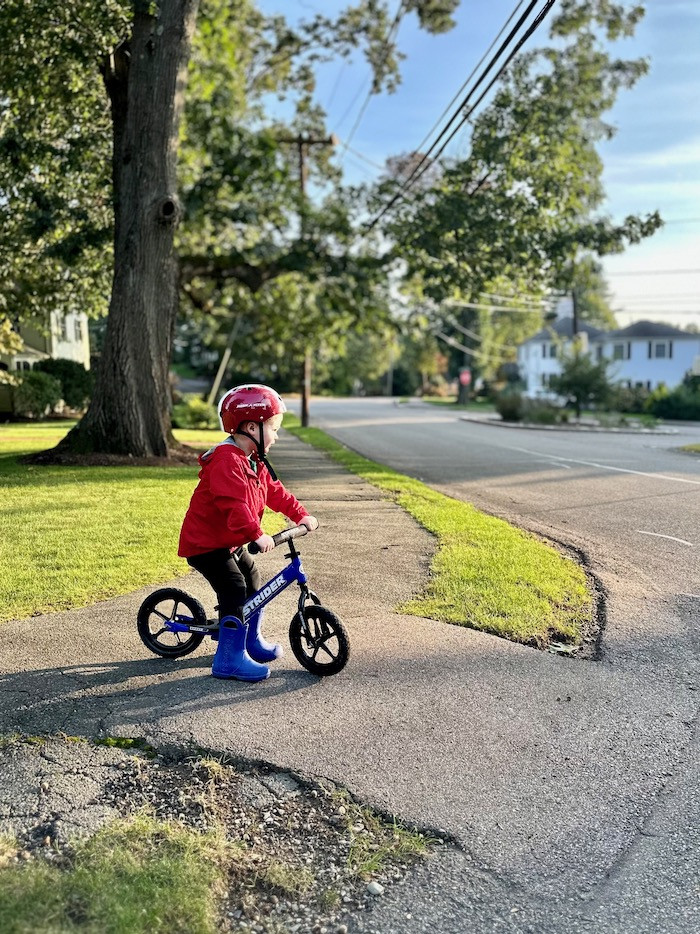 A young child happily riding a red Strider balance bike in a park, showcasing its ease of use and fun factor.
A young child happily riding a red Strider balance bike in a park, showcasing its ease of use and fun factor.
As parents, we’re always on the lookout for toys and gear that are not only fun but also beneficial for our children’s development. Over the years, certain items have consistently stood out for their quality and impact. Think of essentials like a comfortable play couch for imaginative play, a sturdy easel for budding artists, an interactive piano for musical exploration, or even reliable strollers for family outings. When it came to introducing our toddler to the world of bikes, the Strider Balance Bike entered our lives with a bit of initial hesitation, mainly from a parent (me!) nervous about potential tumbles. However, this little bike, seemingly simple with its lack of pedals, brakes, or training wheels, has surprisingly become one of the most cherished items in our household. This comprehensive review will delve into our family’s firsthand experience with the Strider Balance Bike, highlighting its key advantages and disadvantages, and exploring its features in detail to help you decide if it’s the perfect fit for your young one.
Why We Chose a Balance Bike: Ditching the Pedals for Progress
The decision to opt for a balance bike was spearheaded by my husband, the cycling enthusiast in our family. If you’re new to the concept, a balance bike is essentially a bicycle stripped down to its core – no pedals, no training wheels, and often, no traditional hand brakes. The core philosophy is to first instill the fundamental skill of balance in young children, setting the stage for a smoother transition to pedal bikes later on. The idea is that by mastering balance initially, children can often bypass the need for training wheels altogether when they move to a regular two-wheeled bicycle.
Prior to the Strider, our toddler had already shown an interest in various ride-on toys and tricycles, both indoors and outdoors. At just one year old, he started experimenting with a Radio Flyer Scoot 2 Ride on Pedal Bike and a Kinderfeets TinyTot 2-in-1 Wooden Balance Bike and Tricycle. By age two, he was confidently navigating a Radio Flyer 10″ Classic Tricycle.
As his second birthday approached, the conversation shifted towards getting him a dedicated outdoor balance bike. Admittedly, I had reservations. The absence of pedals and training wheels sparked concerns about potential falls and injuries, imagining a lack of control. However, mounting research strongly indicates that children who start with balance bikes tend to learn to ride pedal bikes earlier and more effectively than those who don’t. Furthermore, balance bikes were becoming increasingly common in our neighborhood, and positive testimonials from other parents further solidified our decision to give it a try.
Our Strider 12 Sport Journey: From Walking to Gliding
Several months after our son turned two, we took the plunge and purchased the Strider 12 Sport. The Strider 12 Sport consistently ranks as a top pick for balance bikes, lauded for its excellent value and minimal maintenance requirements. It seemed like the perfect entry point into the world of balance bikes for our family.
From the moment we introduced the Strider, our son was eager to include it in our neighborhood walks. Initially, he would alternate between the balance bike and his Radio Flyer tricycle, but it quickly became apparent that the balance bike allowed him to keep pace with our normal walking speed far more easily. The tricycle, while fun, was becoming less practical for longer distances.
In his early days with the Strider, “riding” mostly resembled walking with the bike providing support underneath him. It took a few months of consistent use before he started to embrace gliding on flat surfaces. To my relief, he was remarkably cautious, gradually building confidence.
After about a year of neighborhood explorations on his Strider, a noticeable shift occurred. He began to confidently cruise down gentle slopes, naturally learning to use his feet as brakes. Now, he happily rides alongside his younger sister in her stroller, keeping a comfortable walking pace. While he’s not performing any daring stunts, the most reassuring aspect is that he has never experienced a fall or injury while riding, a testament to his cautious nature. I anticipate a more adventurous experience with our second child!
 A toddler learning to balance on a Strider bike, demonstrating the adjustable seat height and lightweight frame.
A toddler learning to balance on a Strider bike, demonstrating the adjustable seat height and lightweight frame.
Strider Balance Bike: Pros and Cons – Weighing the Features
After over a year of consistent use, we’ve compiled a detailed breakdown of the features we appreciate most (and least) about the Strider 12 Sport, the specific model we’re reviewing.
Strider Bike Pros:
- Adjustable Size Range: The Strider 12 Sport boasts an impressive range of adjustability in both seat post and handlebar height. This adaptability makes it suitable for children from 18 months all the way up to 5 years old, ensuring longevity and value as your child grows.
- Lightweight and Compact Design: This bike is remarkably light and compact. Its small size and low weight make it incredibly convenient for travel, easily fitting in car trunks for road trips. It’s also a breeze to carry when little legs get tired during outings.
- Tool-Free Assembly and Adjustments: Parents will appreciate the hassle-free assembly and adjustment process. No tools are required to put the Strider together or to modify the seat and handlebar height as your child grows, making on-the-go adjustments simple.
- Maintenance-Free Tires: The Strider’s foam rubber tires are a game-changer for busy parents. They are puncture-proof and never require inflation, eliminating the worry of flat tires and the need for regular maintenance.
- Child-Friendly Frame Design: The frame is thoughtfully designed to be low and easily accessible, allowing young children to mount and dismount the bike with confidence and independence.
- Mini Grips for Small Hands: The handlebars are equipped with mini grips that are specifically designed to be narrow enough for small hands to grasp securely and comfortably, promoting better control.
- Stylish Aesthetics and Customization: The Strider has a modern and appealing design. Furthermore, Strider offers a range of add-on accessories, allowing for personalization and customization to suit your child’s preferences.
Strider Bike Cons:
- Price Point: While not the most expensive balance bike on the market, the Strider 12 Sport is still an investment for parents, typically priced around $130. This may be a consideration for budget-conscious families.
- Off-Road Tire Performance: Compared to balance bikes with air-filled tires, the Strider’s foam tires are not as ideal for rough, off-road terrain. They may not provide the same level of cushioning and grip on uneven surfaces like gravel or trails.
- Lack of Hand Brake: The Strider 12 Sport does not come with a built-in hand brake, unlike some higher-end balance bike models. While children primarily use their feet to brake on balance bikes, a hand brake can offer an additional braking option, especially for more adventurous riders or varied terrains.
Detailed Features of the Strider Balance Bike: A Closer Look
Let’s delve into the specific features and specifications that make the Strider balance bike stand out:
Cost and Value
 A parent adjusting the seat height of a Strider bike, highlighting the tool-free adjustment clamps and ease of use.
A parent adjusting the seat height of a Strider bike, highlighting the tool-free adjustment clamps and ease of use.
The Strider 12 Sport Balance Bike is generally priced around $130. To provide a price comparison, the REI Co-op Cycles REV 12 Kids’ Balance Bike, which is similar in style and features, is currently priced slightly higher.
For parents seeking a more premium balance bike with advanced features like a hand brake, the Woom 1 12-inch Balance Bike is an option, albeit at a significantly higher price point of around $250. For those prioritizing budget, the Banana LT Balance Bike presents a lower-cost alternative at approximately $70. The Strider 12 Sport strikes a balance between features, quality, and price, making it a popular choice for many families.
Size and Weight Specifications
The “12” in Strider 12 Sport refers to its 12-inch wheels. The bike’s overall dimensions are approximately 33 inches in length, 15 inches in width, and 22 inches in height when the handlebar is at its maximum setting. Constructed with a robust steel frame, the Strider maintains a remarkably light weight of just 6.7 pounds.
This lightweight design is a significant advantage for parents. Its compact and manageable size makes it easy to transport and store. While we also appreciate our son’s Radio Flyer Classic Tricycle, its heavier weight (12.4 pounds) and bulkier size make it less convenient to carry when our son’s legs tire out. The Strider’s portability allows me to easily slip it into the basket of our UPPAbaby Vista stroller, enabling our son to ride along on the stroller’s ride-along board when needed.
Age and Size Adjustability
A key factor contributing to the Strider’s popularity is its wide age and size range. Strider claims the 12 Sport model comfortably fits children from 18 months to 5 years old. This extended usability means toddlers can start enjoying the Strider as young as 18 months and continue riding it well into their preschool years. We introduced the Strider to our son when he was just over 2 years old, and even after a year and a half, he still has plenty of room to grow with it.
The Strider 12 Sport has a maximum weight capacity of 60 pounds. The handlebar height adjusts from 18 to 22 inches, and the seat height ranges from 11 to 19 inches. This translates to compatibility with children who have inseams ranging from 12 to 20 inches. The adjustable nature of the Strider was a major selling point for us, as investing in gear that can adapt to rapidly growing children is essential. The tool-free adjustment clamps for both handlebar and seat height are particularly convenient, allowing for quick and easy modifications as needed.
Tire Type and Performance
For cycling enthusiasts, bike maintenance might be second nature. However, for most parents of toddlers, low-maintenance gear is highly desirable. Strider equips the 12 Sport balance bike with 12-inch foam rubber tires and maintenance-free sealed cartridge bearings in the wheels. This combination eliminates the need for tire inflation and ensures puncture-proof performance.
While foam tires offer convenience, parents anticipating primarily off-road riding for their children might consider balance bikes with air-filled tires. Air-filled tires generally provide better shock absorption and traction on uneven terrains like gravel and dirt paths. However, for most young children and typical riding environments, we found the foam tires on the Strider to be more than adequate. The peace of mind of never having to deal with a flat tire during outings was also a significant advantage.
Maneuverability and Handling
 A child easily maneuvering a Strider bike around obstacles, showcasing its responsive steering and lightweight nature.
A child easily maneuvering a Strider bike around obstacles, showcasing its responsive steering and lightweight nature.
The Strider 12 Sport offers a comfortable and intuitive riding experience for young children. Compared to some other toddler bike options, the Strider provides ample space between the seat post and handlebars. This design feature allows children to lean forward naturally, facilitating balance and proper riding posture. It also ensures easy mounting and dismounting.
The Strider’s narrow steel frame is well-suited for smaller bodies, promoting comfortable riding. The bike includes an ergonomic, padded seat with a soft cushion, which our son finds comfortable for extended rides. The textured mini grips on the handlebars are appropriately sized for small hands, offering a secure grip, and the handlebars provide smooth and responsive steering.
Integrated Footrest
A unique and well-loved feature of the Strider 12 Sport is its integrated footrest. Located discreetly under the seat, just in front of the rear wheel, the narrow footrest is positioned to stay out of the way during regular riding. However, it’s perfectly sized for children to rest their heels on while gliding on flat surfaces or gentle downhill slopes. This footrest encourages balance and allows children to practice coasting and further develop their balancing skills.
Safety Considerations
 A child wearing a helmet while riding a Strider bike, emphasizing the importance of safety gear for young riders.
A child wearing a helmet while riding a Strider bike, emphasizing the importance of safety gear for young riders.
While the Strider 12 Sport is thoughtfully designed with safety in mind, parental supervision and safety precautions are always paramount when children are learning to ride. Wearing a helmet is crucial for every ride, and adults should be mindful of traffic and surroundings, ensuring visibility for young cyclists.
Initially, my primary safety concern was related to downhill riding and braking. While toddlers quickly learn to use their feet as brakes on balance bikes, it’s important for parents to avoid overly steep slopes where speed can become difficult to control. The Strider 12 Sport incorporates a cushioned safety pad that wraps around the handlebars, providing added protection in case of bumps or unexpected stops. Proper assembly according to the manufacturer’s instructions and ensuring the bike is appropriately sized for the child are essential safety measures. Incorrect seat and handlebar height can hinder proper braking and control.
Accessories and Customization Options
Strider offers a range of accessories focused on both safety and customization. Safety accessories include a standard helmet, a full-face helmet for more adventurous riding, and a set of elbow and knee pads for added protection.
For cycling-enthusiast parents, Strider provides accessories like a bike mount, a bike stand, and disc wheel covers. For serious upgrades, a high-performance set of carbon wheels is also available.
For aesthetic customization, Ultralight Wheels are offered in seven vibrant colors, sold individually for mixing and matching. Replacement Strider 12 Mini Grips are also available in various colors to add pops of color.
For younger siblings, the Strider 12 Rocking Base transforms the balance bike into a rocking toy for children as young as six months. For year-round fun, snow skis can be attached to the wheels, allowing for balance bike practice even in snowy conditions.
Aesthetic Appeal
 A close-up of a Strider bike highlighting its sleek design, color options, and modern look.
A close-up of a Strider bike highlighting its sleek design, color options, and modern look.
One of the appealing aspects for parents who appreciate cycling aesthetics is that the Strider balance bike, despite being designed for young children, doesn’t look like a typical toy. Its design is sleek and modern, and it’s a bike that even older children would likely be happy to ride.
The Strider 12 Sport is available in seven vibrant colors, including blue, green, matte gray, orange, pink, red, and yellow, allowing parents to choose a color that suits their child’s personality or preference. The overall aesthetic appeal adds to the Strider’s desirability.
Final Verdict: The Strider Balance Bike – A Highly Recommended First Ride
Our family’s experience with the Strider balance bike has been overwhelmingly positive. If we were to make the choice again, we would undoubtedly select the Strider 12 Sport for our children. While we didn’t introduce a balance bike right at 18 months, our son adapted to the technique quickly and genuinely enjoys riding it regularly.
We are optimistic that his experience with the Strider will pave the way for a smooth transition to a pedal bike when he’s ready. For now, the Strider is a fantastic way for our family to enjoy outdoor activities together. It has fostered our son’s confidence, brought countless smiles, and provided a fun and engaging way for him to ride alongside us on our family adventures. For parents seeking a high-quality, durable, and effective balance bike, the Strider Balance Bike is an excellent choice and a worthwhile investment in your child’s development and enjoyment of cycling.
